Related Research Articles

Bajirao I, born as Visaji, was the 7th Peshwa of the Maratha Confederacy. During his 20-year tenure as a Peshwa, he defeated Nizam-ul-Mulk at several battles like the Battle of Palkhed and Battle of Bhopal. Bajirao contributed to Maratha supremacy in Southern India and Northern India. Thus, he was responsible for establishing Maratha power in Gujarat, Malwa, Rajputana and Bundelkhand and liberating Konkan from the Siddis of Janjira and Portuguese rule.He is considered as one of the greatest cavalry generals of India.
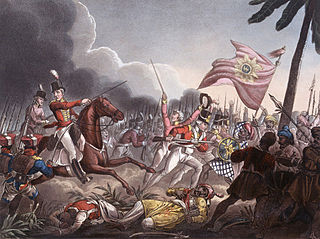
The Second Anglo-Maratha War (1803–1805) was the second conflict between the British East India Company and the Maratha Empire in India.
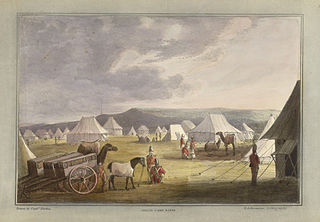
The Third Anglo-Maratha War (1817–1819) was the final and decisive conflict between the British East India Company and the Maratha Empire in India. The war left the Company in control of most of India. It began with an invasion of Maratha territory by British East India Company troops, and although the British were outnumbered, the Maratha army was decimated. The troops were led by Governor General Hastings, supported by a force under General Thomas Hislop. Operations began against the Pindaris, a band of Muslim mercenaries and Marathas from central India.

The Peshwa was the appointed prime minister of the Maratha Empire of the Indian subcontinent. Originally, the Peshwas served as subordinates to the Chhatrapati ; later, under the Bhat family, they became the de facto leaders of the Maratha Confederacy, with the Chhatrapati becoming a nominal ruler. During the last years of the Maratha Empire, the Peshwas themselves were reduced to titular leaders, and remained under the authority of the Maratha nobles and the British East India Company.

Nana Saheb Peshwa II, born as Dhondu Pant, was an Indian Peshwa of the Maratha empire, aristocrat and fighter, who led the rebellion in Cawnpore (Kanpur) during the 1857 rebellion. As the adopted son of the exiled Maratha Peshwa Baji Rao II, Nana Saheb believed that he was entitled to a pension from the East India Company, but the underlying contractual issues are rather murky. The Company's refusal to continue the pension after his father's death, as well as what he perceived as high-handed policies, led him to join the rebellion. He forced the British garrison in Kanpur to surrender, then murdered the survivors, gaining control of Kanpur for a few days. He later disappeared, after his forces were defeated by a British force that recaptured Kanpur. He later fled to Nepal, where he was said to have died in September 1859.

Balaji Bajirao, often referred to as Nana Saheb I, was the 8th Peshwa of the Maratha Confederacy. He was appointed as Peshwa in 1740 upon the death of his illustrious father, the Peshwa Bajirao I.

The Holkars were a powerful family that was part of the Maratha Confederacy, which held the rank of subahdar under Peshwa Baji Rao I. When the Maratha Empire began to weaken due to internal clashes, the Holkars declared themselves rulers of the Indore in Central India, which existed as an independent member of the Maratha Empire until 1818. Later, their kingdom became a princely state under the protectorate of British India.
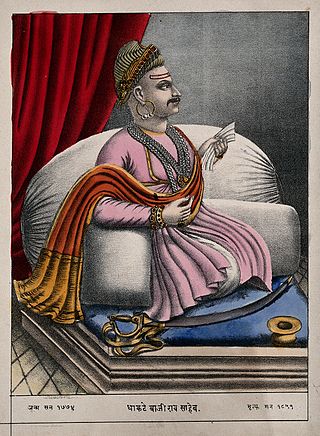
Baji Rao II was the 13th and the last Peshwa of the Maratha Confederacy. He governed from 1795 to 1818. He was installed as a puppet ruler by the Maratha nobles, whose growing power prompted him to flee his capital Poona and sign the Treaty of Bassein (1802) with the British. This resulted in the Second Anglo-Maratha War (1803–1805), in which the British emerged victorious and re-installed him as the titular Peshwa. In 1817, Baji Rao II joined the Third Anglo-Maratha War against the British, after they favoured the Gaekwad nobles in a revenue-sharing dispute. After suffering several battle defeats, the Peshwa surrendered to the British, and agreed to retire in return for an estate at Bithoor and an annual pension.
The Battle of Palkhed was fought on February 28, 1728 at the village of Palkhed, near the city of Nashik, Maharashtra, India between the Maratha Empire and the Nizam-ul-Mulk, Asaf Jah I of Hyderabad wherein, the Marathas defeated the Nizam.
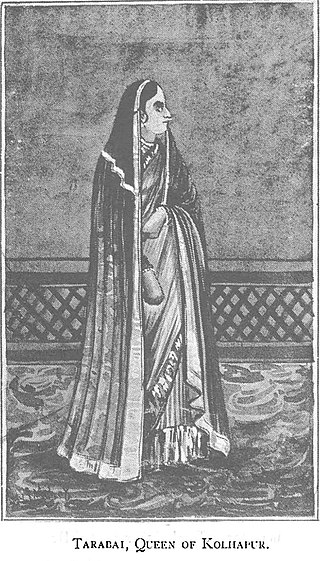
Tarabai Bhosale was the regent of the Maratha Empire of India from 1700 until 1708. She was the empress of Rajaram Bhonsale, and daughter-in-law of the empire's founder Chatrapati Shivaji Maharaj. She is acclaimed for her role in keeping alive the resistance against Mughal occupation of Maratha territories after the death of her husband, and acting as the regent during the minority of her son, Shivaji II.
The Battle of Mahidpur was fought during the Third Anglo-Maratha War between the Holkar faction of the Maratha Confederacy and the British East India Company at Mahidpur, a town in the Malwa region, on 21 December 1817.

The Treaty of Bassein was a pact between the English East India Company and Baji Rao II, the Maratha confederacy's Peshwa, it was signed on 31 December 1802 after the Battle of Poona, at the present day Bassein (Vasai). The treaty was a decisive step in the dissolution of the Maratha Empire, which led to the East India Company's annexation of the empire's territories in western India in 1818.

A subsidiary alliance, in South Asian history, was a tributary alliance between an Indian state and a European East India Company.
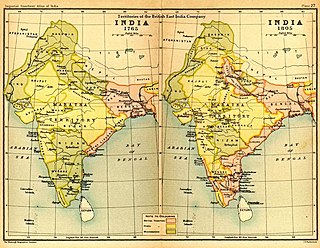
The Maratha Conquests were a series of conquests in the Indian subcontinent which led to the building of the Maratha Empire. These conquests were started by Shivaji in 1659, from the victory at the Battle of Pratapgad against Bijapur. The expansion of the empire was limited and interrupted by the Mughal conquests of south India by Mughal emperor Aurangzeb. Marathas were forced to defend their territories against the overwhelmingly strong Mughal army in the 27 years long Deccan wars. They were able to defend their territories and gain an upper hand over Mughals in the sustained conflict.

Shrimant Peshwa Madhav Rao Bhat II was the 12th Peshwa of the Maratha Empire in India, from his infancy. He was known as Sawai Madhav Rao or Madhav Rao Narayan. He was the posthumous son of Narayanrao Peshwa, murdered in 1773 on the orders of Raghunathrao. Madhavrao II was considered the legal heir, and was installed as Peshwa by the Treaty of Salbai in 1782 after First Anglo-Maratha War.
Baloji Kunjar / Kunjir (17??–1816) was Sardar and Minister of Affairs in service of Peshwa Baji Rao II. He was Peshwa Baji Rao II's favorite. After the death of Peshwa Sawai Madhavrao, there was debates for the position of Peshwa among the Maratha Empire. Balaji Kunjar performed a successful role to convey most friendly declaration and assurance between Baji Rao II and Nana Phadanvis, to appoint Baji Rao II as peshwa of Maratha Empire. Peshwa Baji Rao II and Nana Phadanvis awarded inam (Jagir) to him in 14 villages near Purandhar fort, for his role. He performed successful role in administration of maratha empire and as affairs minister or diplomat (vakil) for Peshwa Baji Rao II. He along with his son Pandoji Kunjar and Narayan, enjoyed the position as Sur-Patil (सर-पाटील) at Pune Punch Mahals during the era of Peshawa Baji Rao II. He along with his family has long enjoyed the privileges of sar-patil of 360 villages and towns in the Subha of Poona.
The Bhat Peshwa family earlier known as Bhat family is a prominent Indian Chitpavan Brahmin family who dominated India for around 100 years in the late 18th century and early 19th century. Most of the members in this family were the Peshwas in the Peshwa Era of the Maratha Empire, and Peshwa later became their family name. During their regime, most of the Indian subcontinent was under their control. The last Peshwa, Baji Rao II, was defeated by the British East India Company in the Third Anglo-Maratha War in 1818. The territory was annexed to the British East India Company's Bombay Presidency, and he was pensioned
Amrut Rao was a Maratha noble, and the adopted son of Peshwa Raghunath Rao. In 1803, Yashwant Rao Holkar invaded Pune and deposed his adoptive brother Peshwa Baji Rao II. Subsequently, Holkar set up an ad hoc council nominally headed by Amrut Rao, and ran the Peshwa's government in his name. Holkar also installed Amrut Rao's son Vinayak Rao as the Peshwa to strengthen the legal status of his government, because Vinayak had been adopted by the widow of the deceased Peshwa Madhav Rao II. However, Baji Rao sought assistance from the British East India Company, whose advance forced Amrut Rao and his son to flee Pune. Subsequently, Amrut Rao signed a treaty with the British, agreeing to give up all claims over the Peshwa's office in return for a pension and an estate in Bundelkhand.
Siva Rao was a member of the Ghorpade Dynasty who served as the ruler of Sandur from 1796 to 1817 and 1818 to 1840. In 1799, Siva Rao signed as treaty of Subsidiary Alliance with the East India Company.
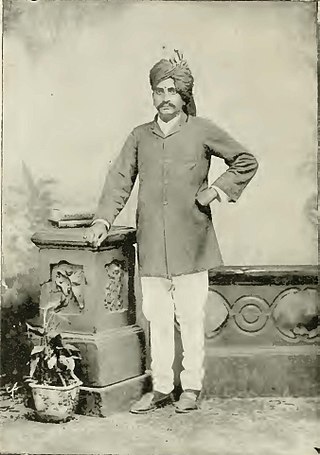
The Dhulap family was a Maratha noble family of the Maratha Empire in the late 18th century-early 19th century who were hereditary sarkhels or supreme commanders of the Maratha Navy during its decline. They came to power after the Angre family's downfall and Tulaji Angre's defeat at the Battle of Vijaydurg by the East India Company. Rudraji Dhulap and his son Anandrao Dhulap successively served as grand admirals of the Maratha Navy.
References
- ↑ Naravane, M.S. (2014). Battles of the Honorourable East India Company. A.P.H. Publishing Corporation. pp. 79–80. ISBN 9788131300343.
- ↑ Bundelkhand - Encyclopædia Britannica